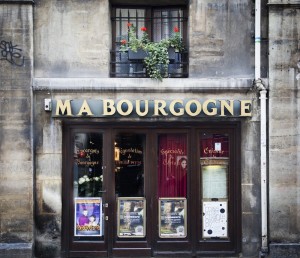We all have favorite books about favorite places. I happen to love Paris and my three favorite books 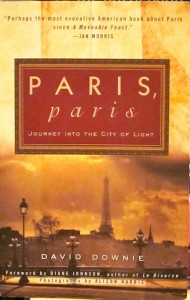 illuminating the city are Ernest Hemingway’s “A Moveable Feast, Gertrude Stein’s “The Autobiography of Alice B. Toklas” and David Downie’s “Paris, Paris Journey into the City of Light.”
illuminating the city are Ernest Hemingway’s “A Moveable Feast, Gertrude Stein’s “The Autobiography of Alice B. Toklas” and David Downie’s “Paris, Paris Journey into the City of Light.”
Although it is possible (and totally pleasurable) to explore 1920s Paris through Gertrude and Ernest, David is alive and well and living in Paris and writes about the present with such clarity that no tourist should venture fourth without his direction.
David’s views of Paris flow between the essential, quirky and shocking (I am never going to drink Paris tap water again after reading his description of the Seine). His writing is always fresh and his adventures, interesting, so Sweet Leisure is especially pleased to have David share a few of his favorite Paris jaunts and haunts. In his own words:
Discovering David Downie’s Paris, Paris
Copyright David Downie, Oct 2012
The Luxembourg: Sit, Stroll, Sip Coffee nearby
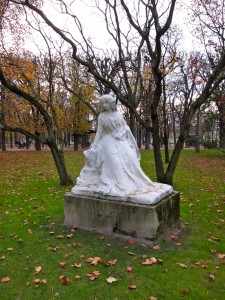
George Sand
It’s easy to guess why the Luxembourg Garden is my favorite park in town. That’s saying a lot in this city of fabulous gardens. Where else can you see George Sand, Charles Baudelaire and Frédéric Chopin – not to mention Alfred de Musset and Henri Murger of “La Bohème – striking poses as if resurrected from the dead? Mossy sculptures of my Romantic idols lurk amid the greenery of the garden’s meandering paths. I like to pay homage to them several times a week. Even after 26 years of living in Paris it’s a learning experience. In my book “Paris, Paris: Journey into the City of Light” the chapter about the Luxembourg Garden explores how Parisians – and visitors – often spend entire days lounging here. Watching ducks in a pool—or lovers sitting by the Médicis Fountain—can be as instructive as reading reams of history. Before or after a stroll I clock in at Café Rostand facing the park, to sip strong coffee and read the local papers. The coffee is not great but the atmosphere is. You can hear the ticks from the big round clock hanging from the ceiling: there’s no Wi-Fi, no corporate spiel, and no rush. The service is totally Parisian and un-subservient.
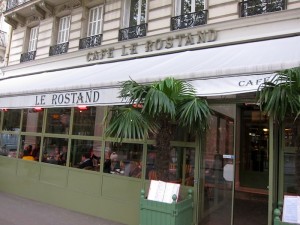
Discovering the Blvd Richard-Lenoir open market, Café de l’Industrie and Canal St-Martin
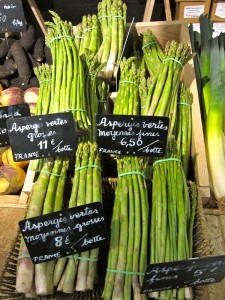 Every Thursday and Sunday morning you know where I’ll be: the open market on Boulevard Richard Lenoir abutting Place de la Bastille. It just happens to be Paris’s best. We buy housewares—from burner-top toasters to flexi-spigots—fruit, vegetables, range-raised poultry, fish, and cheese from family-run business with stands here, many of them certified organic. Even if I’m not going to shop I come to view the merchandise, enjoy an espresso at blissfully quiet, cozy Café de l’Industrie (one block east of the market), and then walk up the boulevard to the Canal Saint Martin. It runs underneath the central esplanade in the middle of Boulevard Richard Lenoir where the market is held. The underground canal emerges into a tiny park under spreading sycamores. That’s where the Quai de Jemmapes and Quai de Valmy begin. The first humpback bridge leaps over the canal about 100 yards further along. From there all the way to the edge of Paris you stroll by a series of tuneful locks, stretches of placid, greenish water, trees five stories high, plus nightclubs, restaurants, cafes and self-adoring Parisian trendies who are more fun to watch than tame peacocks. This is one of the city’s current hangouts for hipsters.
Every Thursday and Sunday morning you know where I’ll be: the open market on Boulevard Richard Lenoir abutting Place de la Bastille. It just happens to be Paris’s best. We buy housewares—from burner-top toasters to flexi-spigots—fruit, vegetables, range-raised poultry, fish, and cheese from family-run business with stands here, many of them certified organic. Even if I’m not going to shop I come to view the merchandise, enjoy an espresso at blissfully quiet, cozy Café de l’Industrie (one block east of the market), and then walk up the boulevard to the Canal Saint Martin. It runs underneath the central esplanade in the middle of Boulevard Richard Lenoir where the market is held. The underground canal emerges into a tiny park under spreading sycamores. That’s where the Quai de Jemmapes and Quai de Valmy begin. The first humpback bridge leaps over the canal about 100 yards further along. From there all the way to the edge of Paris you stroll by a series of tuneful locks, stretches of placid, greenish water, trees five stories high, plus nightclubs, restaurants, cafes and self-adoring Parisian trendies who are more fun to watch than tame peacocks. This is one of the city’s current hangouts for hipsters.
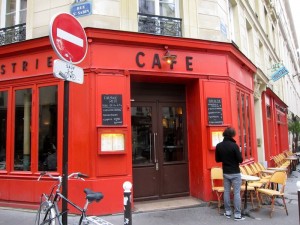
Cafe de l'Industrie
Breakfast coffee or aperitif at Ma Bourgogne on Place des Vosges
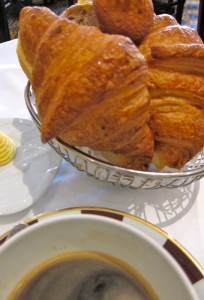 The sunny, western side of the Place des Vosges—the centerpiece of the fashionable Marais neighborhood—has long been colonized by the tables of Ma Bourgogne, a café-restaurant on the corner of the square. Several times a week I come here for a simple breakfast—coffee, croissants, a glass of water or juice. Some people swear the food is more than edible (that has not been my experience over the last decades). My advice is, stick to something simple and liquid like coffee or a glass of wine. The view takes in the arcades and pavilions of the famous, 400-year-old square, plus of course the comings and goings of the politicos and plutocrats who live here. One former minister happens to live practically next door to Ma Bourgogne, another bigwig embroiled in high-color sexual controversies hides out just a few pavilions down. Watching them slide smoothly from their dark-windowed limos into the entrances of their $10 million apartments is both amusing and instructive. You begin to understand why the French Revolution happened. The best views of the square are from on high—from those apartments—but nothing beats sitting on a bench under the clipped lindens and listening to the fountains. It’s entirely cost free.
The sunny, western side of the Place des Vosges—the centerpiece of the fashionable Marais neighborhood—has long been colonized by the tables of Ma Bourgogne, a café-restaurant on the corner of the square. Several times a week I come here for a simple breakfast—coffee, croissants, a glass of water or juice. Some people swear the food is more than edible (that has not been my experience over the last decades). My advice is, stick to something simple and liquid like coffee or a glass of wine. The view takes in the arcades and pavilions of the famous, 400-year-old square, plus of course the comings and goings of the politicos and plutocrats who live here. One former minister happens to live practically next door to Ma Bourgogne, another bigwig embroiled in high-color sexual controversies hides out just a few pavilions down. Watching them slide smoothly from their dark-windowed limos into the entrances of their $10 million apartments is both amusing and instructive. You begin to understand why the French Revolution happened. The best views of the square are from on high—from those apartments—but nothing beats sitting on a bench under the clipped lindens and listening to the fountains. It’s entirely cost free.
Riding the #69 bus across town
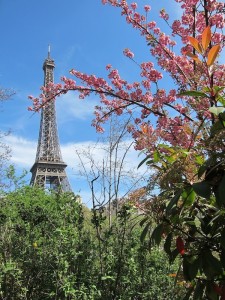 Another cheap and cheery way to experience the Paris of Parisians is to ride the #69 bus from the esplanade facing the Eiffel Tower across the posh 7th arrondissement and the edge of Saint Germain des Près to the quays of the Seine. After crossing to the Right Bank the bus trundles by City Hall, wends its way through the Marais to busy Place de la Bastille, then lumbers northeast along working-class Rue de la Roquette to Père Lachaise cemetery. From there it’s another few minutes to the top of the hill at the terminus on Place Gambetta in the 20th arrondissement. For the cost of a single bus ticket in the space of an hour you see scores of monuments, churches, bridges, gorgeous cityscapes, the haunts of the super-rich and the dives of the destitute. An added benefit: listening in on conversations and watching the locals interact (shoving, arguing and doing all the things Parisians adore).
Another cheap and cheery way to experience the Paris of Parisians is to ride the #69 bus from the esplanade facing the Eiffel Tower across the posh 7th arrondissement and the edge of Saint Germain des Près to the quays of the Seine. After crossing to the Right Bank the bus trundles by City Hall, wends its way through the Marais to busy Place de la Bastille, then lumbers northeast along working-class Rue de la Roquette to Père Lachaise cemetery. From there it’s another few minutes to the top of the hill at the terminus on Place Gambetta in the 20th arrondissement. For the cost of a single bus ticket in the space of an hour you see scores of monuments, churches, bridges, gorgeous cityscapes, the haunts of the super-rich and the dives of the destitute. An added benefit: listening in on conversations and watching the locals interact (shoving, arguing and doing all the things Parisians adore).
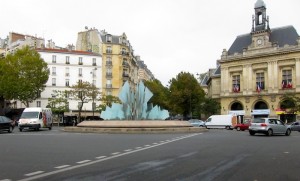
Place Gambetta
Pere Lachaise Cemetery
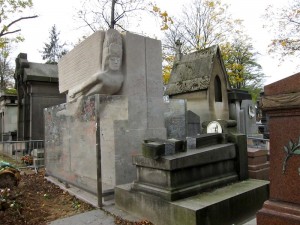
Oscar Wilde's Tomb
Get off the #69 at the top of Rue de la Roquette and enter Paris’s biggest, most atmospheric graveyard. My office for 19 years was a block from Pere Lachaise, the most impressive and magical cemetery I know anywhere. It’s over 200 years old and filled with the often extraordinary tombs of about 1 million Frenchmen, women, children and a variety of mostly famous foreigners. There are 70,000 family tombs all told, most of them filled with multiple occupants. In “Paris, Paris: Journey into the City of Light” the chapter about Pere Lachaise and another chapter about the historic cemeteries of Paris tells the tale of how I became a habitué. It wasn’t just the proximity of my office to the cemetery. Even before I moved into that office I was always glad to visit my dearly departed literary and artistic friends—Delacroix, Abelard & Heloise, Balzac, Molière —plus a few of my enemies. What pleasure I still get from seeing the banal little tomb of the once-terrifying Baron Haussmann, who evicted over 300,000 Parisians and destroyed 25,000 buildings at the behest of Napoleon III! Respect is not what I pay him. Sometimes I pick up a sandwich at a nearby bakery in Place Auguste Métivier and eat on a bench—or seated on a comfy old tomb—under the towering trees that grow up out many a tomb. The dead don’t seem to mind. In fact more than once I’ve had the distinct impression Oscar (that’s Oscar Wild) wished me bon appétit.
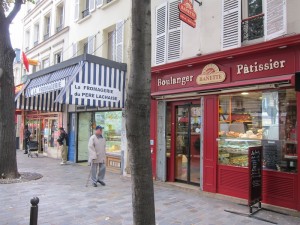
In the Place Auguste Metivier
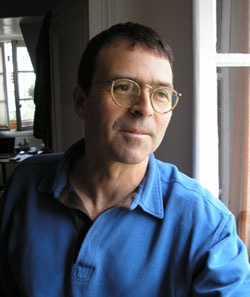 Paris- and Rome-based writer David Downie is the author of the critically acclaimed “Paris, Paris: Journey into the City of Light” plus three books on Rome. His latest adventure travel memoir, “Paris to the Pyrenees: A Skeptic Pilgrim Walks the Way of Saint James” is published in April, 2013. Downie is also a guide, creating custom tours of Paris, Rome, Burgundy and the Italian Riviera for private clients. His websites are www.davidddownie.com, http://blog.davidddownie.com and www.parisparistours.com.
Paris- and Rome-based writer David Downie is the author of the critically acclaimed “Paris, Paris: Journey into the City of Light” plus three books on Rome. His latest adventure travel memoir, “Paris to the Pyrenees: A Skeptic Pilgrim Walks the Way of Saint James” is published in April, 2013. Downie is also a guide, creating custom tours of Paris, Rome, Burgundy and the Italian Riviera for private clients. His websites are www.davidddownie.com, http://blog.davidddownie.com and www.parisparistours.com.

